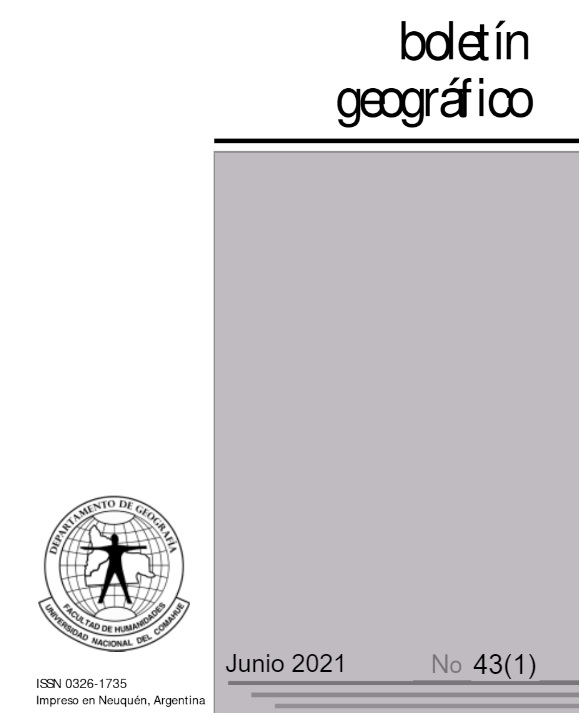Shallow lakes response to climate variability in transversal valleys (La Pampa, Argentina)
Keywords:
Lagoons morphometric, Extreme climatic events, Transversal valleys, La PampaAbstract
Shallow lakes present different responses to flooding and drought events. This paper presents ananalysis of rainfall variability was carried out using the Standardized Precipitation Index (SPI) applied to several locations in the study area with rainfall data from 1960-2017to understand the response of this lagoon system to extreme events to enhanceearly warning.The morphometric variations of the shallow lakes and temporary pondswere also analyzed using, Landsat 5 TM path / row 228/086 satellite images followingby Hutchinson (1957). The results indicatesthat the shallow lake system is characterized by the heterogeneity in the morphometric responses of water surfaces during extreme events of flooding and drought. On the other hand, in the northern andeastern areas of transversal valleys there were wetter and more extreme periods, but southern zones presented longer periods of drought. Thetotal surface covered with water in extreme flood events wasfour times the extreme drought eventsarea. The morphometric responses have aSW-NE direction in drought, while in flood events reverses toNE -SW. Therefore, monitoring morphometric variations of temporary pools would constitute a fundamental tool in the management of early warning advice inregional floods and droughtssituations.
Downloads
References
Adrian, R., O’Reilly, C. M., Zagarese, H., Baines, S., Hessen, D., Keller, W., Livingstone, D., Sommaruga, R., Straile, D., Van Donk, E., Weyhenmeyer, G. y Winder, M. (2009). Lakes as sentinels of climate change. Limnology Oceanography, 54(6, part 2), 2283-2297.
Aliaga, V. S., Ferrelli, F., Alberdi Algañaraz, E. D. y Piccolo, M.C. (2016). Distribución y variabilidad de la precipitación en la región Pampeana, Argentina. Cuadernos de Investigación Geográfica, 42(1), 261-280.
Berón, M., Carrera Aizpitarte, M. y Páez, F. (2015). Arqueología en el área de valles transversales (provincia de La Pampa, Argentina). Caracterización y tendencias de los conjuntos arqueológicos. Implicancias sociales en la construcción del paisaje. Relaciones de la Sociedad Argentina de Antropología, XL (2), 549-587.
Cabrera, A. L. (1976). Regiones fitogeográficas argentinas en Kugler WF (Ed.), Enciclopedia Argentina de agricultura y jardinería. 2° Ed. Acme. S.A.C.I. Buenos Aires, Tomo II, Fascículo 1, 85 pp.
Canevari, P., Blanco, D. E., Bucher, E., Castro, G. y Davidson, I. (Eds.). (1999). Los humedales de la Argentina. Clasificación, situación actual, conservación y legislación. Wetlands International, 46, 1-208.
Contreras, F. I. (2015). El impacto ambiental del crecimiento espacial de la ciudad de corrientes sobre lagunas periurbanas. Boletín Geográfico, 37, 29- 42.
Contreras F. I., Ojeda E. A. y Contreras, S. A. (2014). Aplicación de la Línea de Costa en el estudio morfométrico de las lagunas de las lomadas arenosas de Corrientes, Argentina. Contribuciones Científicas GAEA, 26, 65-78.
Contreras, F. I. y Contreras, S. A. (2017). La Incidencia de la Pendiente en la Distribución de las Morfologías de las Lagunas sobre Lomadas Arenosas (Corrientes, Argentina). Anuario do Instituto de Geociencias, 40(1),15-25.
Contreras, F. I. y Paira, A. R. (2015). Comparación morfométrica entre lagunas de la planicie aluvial del río Paraná Medio y la Lomada Norte (Corrientes, Argentina). Cuadernos de Geografía: Revista Colombiana de Geografía, 24 (1), 61-71.
Contreras, F. I. y Paira, A. R. (2016). Aplicación del “índice de cambio” a las variaciones morfométricas de las lagunas de lomadas arenosas. El caso de Bella Vista (Corrientes, Argentina). Revista de Geografía, 21, 31-38.
Contreras, F. I., Ferrelli, F. y Piccolo, M. C. (2020). Impactos de eventos secos y lluviosos sobre cuerpos de agua periurbanos subtropicales: Aporte al ordenamiento del espacio urbano de Corrientes (Argentina). Finisterra, 55(114), 3-22.
Contreras, F. I., Mavo Mastretta, G. M., Piccolo, M. C. y Perillo, G. M. (2021). Spatio-temporal variability monitoring of the floods in the center-west of the Buenos Aires province (Argentina) using remote sensing techniques. The role of sand dunes. Cuadernos de Investigación Geográfica, 47 (pre-print).
Contreras, F. I. y Odriozola, M. P. (2016). Aplicación de Modelos de Elevación Digital para la delimitación de áreas de riesgo por inundaciones. San Luis del Palmar, Corrientes, Rca. Argentina. Contribuciones Científicas GAEA, 28, 83-94.
Coops, H., Beklioglu, M. y Crisman, T. (2003). The role of water-level fluctuations in shallow lake ecosystems – workshop conclusions. Hydrobiologia, 506, 23-27.
Dangavs, N. (2005). Los ambientes acuáticos de la provincia de Buenos Aires en Barrio, R. E., Etcheverry, R. O., Caballé, M. F. y Llambías, E. (Eds.), Geología y recursos minerales de la provincia de Buenos Aires (Cap. XIII, 219-235).
Geraldes, A. M. y Boavida, M. J. L. (2005). Seasonal water level fluctuations: implications for reservoir limnology and management. Lakes & Reservoires: Research and Management, 10(1), 59-69.
Geraldi, A., Piccolo, C. y Perillo, G. (2011). Lagunas bonaerenses en el paisaje pampeano. Ciencia hoy, 21(123), 9-14.
Gronewold, A. D., Bruxer, J., Durnford, D., Smith, J. P., Clites, A. H., Seglenieks, F., Gian, S., Hunter, T. S. y Fortin, F. (2016). Hydrological drivers of record-setting water level rise on Earth’s largest lake system. Water Resources Research, 52(5), 4026-4042.
Hofmann, H., Lorke, A. y Peeters, F. (2008). Temporal scales of water level fluctuations in lakes and their ecological implications. Hydrobiologia, 613, 85-96.
Hutchinson, G. E. (1957). A Treatise on Limnology. l. Geography, Physics and Chemistry. John Wiley y Sons.
Lehner, B., Döll, P., Alcamo, J., Henrichs, T. y Kaspar, F. (2006). Estimating the impact of global change on flood and drought risks in Europe: a continental, integrated analysis. Climatic Change, 75, 273-299.
López Mera, R., López Ramírez, E. y Millán Malo, G. C. (2015). Proyecto “observatorio de conflictos por el agua en México”. Secretaría de Ambiente y Recursos Naturales.
Lorenzo, F. R. (2012). Estratigrafía y sedimentología de los depósitos pelíticos de la formación cerro azul (mioceno tardío) aflorantes en los valles transversales de La Pampa. Tesis de grado. Universidad Nacional de La Pampa, Santa Rosa.
Lorenzo, F., Mehl, A. y Zárate, M. (2013). Sedimentología y estratigrafía de depósitos del Mioceno tardío de los valles transversales de la Pampa. Latin American Journal of Sedimentology and Basin Analysis, 20, 67-84.
McKee, T. B., Doesken, N. J. y Kliest, J. (17-22 enero de 1993). The relationship of drought frequency and duration to time scales. In: Proceedings of the 8th Conference of Applied Climatology. American Meteorological Society, Boston.
NDCM (2020). SPI Program. Disponible en: https://drought.unl.edu/droughtmonitoring/SPI/SPIProgram.aspx
Paira, A. y Drago, E. (2006). Genetical, Morphological and Evolutional Relationships of the Floodplain Lakes in the Middle Parana River Hydrosystem. Zeitschriftfur Geomorphologie 145, 207-228.
Natenzon, C. E. (2007). Riesgo, prevención, mitigación y adaptación. Aportes al eje temático sobre Seguridad Humana. En: E. Tancredi y N. Da Costa Pereira (Coord). Dimensiones Humanas del Cambio Ambiental en Argentina. Hacia la construcción de una Agenda Científica Ambiental Interinstitucional. Univ. Nacional de Luján.
Rosenzweig, C., Major, D. C., Demong, K., Stanton, C., Horton, R. y Stults, M. (2007). Managing climate change risks in New York City's water system: Assessment and adaptation planning. Mitigation and Adaptation Strategies Global Change, 12(8), 1391-1409.
Satya Panigrahi, J., Wikner, R. C., Panigrahy, K., Satapathy, K. y Acharya, B. C. (2009). Variability of nutrients and phytoplankton biomass in a shallow brackish water ecosystem Chilika Lagoon, (India). Limnology, 10(2), 73-85.
Torremorel, A., Bustigorry, J., Escaray, R. y Zagarese, H. (2007). Seasonal dynamics of a large, shallow lake, laguna Chascomús: The role of light limitation and other physical variables. Limnologica. Ecology and Management of Inland Waters, 37(1), 100-108.
Visconti, G., Melchor, R., Montalvo, C. y Umazano, A. y De Elorriaga, E. (2010). Análisis litoestratigráfico de la formación Cerro Azul, (Mioceno Superior en la prov. de La Pampa). Revista de la Asociación Geológica Argentina, 67(2), 257-265.
Wantzen, K. M., Rothaupt, K. O., Mortl, M., Cantonati, M., Toth, L. y Fischer, P. (2008). Ecological effects of water-level fluctuations in lakes: an urgent issue. Hydrobiologia, 613, 1-4.
Williamson, C., Saros, J., Warwick, V. y Smold, J. (2009). Lakes and reservoirs as sentinels, integrators, and regulators of climate change. Limnology and Oceanography, 54 (6, part 2), 2273-2282.
Published
How to Cite
Issue
Section
License
Copyright (c) 2021 Boletin GeográficoTransfer of rights and data processing
The acceptance of an article for publication in the Journal Geographic Bulletin implies the cession of the rights of printing and reproduction, by any means and means, of the author in favor of the Department of Geography of the National University of Comahue, which will not reject any request reasonable for the authors to obtain permission to reproduce their contributions. The total or partial reproduction of the works published in the Geographic Bulletin must be done citing the origin, otherwise, the copyright is violated.
Likewise, it is understood that the concepts and opinions expressed in each work are the sole responsibility of the author, without being responsible or in solidarity, necessarily, neither the editorial staff nor the editorial staff.
It is the responsibility of the authors to be able to provide interested readers with copies of the raw data, procedure manuals, scores and, in general, relevant experimental material.
Likewise, the Management of the journal guarantees the appropriate treatment of personal data
COPYRIGHT TRANSFER FORM

















 Journal of the
Journal of the 